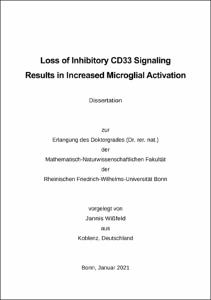Wißfeld, Jannis: Loss of Inhibitory CD33 Signaling Results in Increased Microglial Activation. - Bonn, 2021. - Dissertation, Rheinische Friedrich-Wilhelms-Universität Bonn.
Online-Ausgabe in bonndoc: https://nbn-resolving.org/urn:nbn:de:hbz:5-62767
Online-Ausgabe in bonndoc: https://nbn-resolving.org/urn:nbn:de:hbz:5-62767
@phdthesis{handle:20.500.11811/9178,
urn: https://nbn-resolving.org/urn:nbn:de:hbz:5-62767,
author = {{Jannis Wißfeld}},
title = {Loss of Inhibitory CD33 Signaling Results in Increased Microglial Activation},
school = {Rheinische Friedrich-Wilhelms-Universität Bonn},
year = 2021,
month = jun,
note = {CD33 is expressed on immune cells of myeloid origin, such as macrophages and microglia. Upon activation, CD33 recruits and activates protein tyrosine phosphatases, which results in attenuation of the activatory signaling pathway. Recently, polymorphisms in the CD33 gene were linked to late-onset Alzheimer’s disease (AD). However, the exact function of CD33 in AD remains to be discovered.
In the present thesis, the transcriptome of human induced pluripotent stem cell-derived microglia (iPSdMiG) was compared to human primary microglia in a first step. The in silico RNA sequencing analysis showed that the transcriptome of iPSdMiG closely resembled that of human primary microglia. Furthermore, a CD33 reporter cell line was generated to identify possible modulators of CD33 signaling. The reporter cell lines expressed a fusion protein consisting of the extracellular domain of either human full-length CD33M or exon 2-deleted CD33ΔE2 linked to the transmembrane and intracellular domains of the DNAX-Activation Protein 12 (DAP12). CD33 activation was observed in CD33M, but not in CD33ΔE2-expressing reporter cells by the CD33 antibody clone P67.6 and partially by clone 1c7/1. Both antibodies were confirmed to activate CD33 by antagonizing TREM2-induced phosphorylation of SYK in iPSdMiG. Moreover, the impact of CD33 signaling on microglial homeostasis was analyzed using wild type and isogenic CD33 knockout (CD33-/-) as well as CD33ΔE2-expressing iPSdMiG. CD33-/- and CD33ΔE2-expressing iPSdMiG showed increased mRNA levels of inflammatory cytokines and chemokines. Increased gene transcript levels and surface expression of several microglial receptors was observed in CD33-/- but not CD33ΔE2-expressing iPSdMiG. Further, CD33-/- and CD33ΔE2-expressing iPSdMiG showed an increase in SYK phosphorylation and phagocytosis of amyloid ß1-42 as well as bacterial particles. The phagocytosis-associated oxidative burst was only increased in CD33-/- but not CD33ΔE2-expressing iPSdMiG.
In summary, both, deletion of CD33 and expression of CD33ΔE2 resulted in increased microglial activation in human iPSdMiG, which might be beneficial in respect to AD. However, CD33-/- but not CD33ΔE2 led to a presumable neurotoxic increased oxidative burst in iPSdMiG.},
url = {https://hdl.handle.net/20.500.11811/9178}
}
urn: https://nbn-resolving.org/urn:nbn:de:hbz:5-62767,
author = {{Jannis Wißfeld}},
title = {Loss of Inhibitory CD33 Signaling Results in Increased Microglial Activation},
school = {Rheinische Friedrich-Wilhelms-Universität Bonn},
year = 2021,
month = jun,
note = {CD33 is expressed on immune cells of myeloid origin, such as macrophages and microglia. Upon activation, CD33 recruits and activates protein tyrosine phosphatases, which results in attenuation of the activatory signaling pathway. Recently, polymorphisms in the CD33 gene were linked to late-onset Alzheimer’s disease (AD). However, the exact function of CD33 in AD remains to be discovered.
In the present thesis, the transcriptome of human induced pluripotent stem cell-derived microglia (iPSdMiG) was compared to human primary microglia in a first step. The in silico RNA sequencing analysis showed that the transcriptome of iPSdMiG closely resembled that of human primary microglia. Furthermore, a CD33 reporter cell line was generated to identify possible modulators of CD33 signaling. The reporter cell lines expressed a fusion protein consisting of the extracellular domain of either human full-length CD33M or exon 2-deleted CD33ΔE2 linked to the transmembrane and intracellular domains of the DNAX-Activation Protein 12 (DAP12). CD33 activation was observed in CD33M, but not in CD33ΔE2-expressing reporter cells by the CD33 antibody clone P67.6 and partially by clone 1c7/1. Both antibodies were confirmed to activate CD33 by antagonizing TREM2-induced phosphorylation of SYK in iPSdMiG. Moreover, the impact of CD33 signaling on microglial homeostasis was analyzed using wild type and isogenic CD33 knockout (CD33-/-) as well as CD33ΔE2-expressing iPSdMiG. CD33-/- and CD33ΔE2-expressing iPSdMiG showed increased mRNA levels of inflammatory cytokines and chemokines. Increased gene transcript levels and surface expression of several microglial receptors was observed in CD33-/- but not CD33ΔE2-expressing iPSdMiG. Further, CD33-/- and CD33ΔE2-expressing iPSdMiG showed an increase in SYK phosphorylation and phagocytosis of amyloid ß1-42 as well as bacterial particles. The phagocytosis-associated oxidative burst was only increased in CD33-/- but not CD33ΔE2-expressing iPSdMiG.
In summary, both, deletion of CD33 and expression of CD33ΔE2 resulted in increased microglial activation in human iPSdMiG, which might be beneficial in respect to AD. However, CD33-/- but not CD33ΔE2 led to a presumable neurotoxic increased oxidative burst in iPSdMiG.},
url = {https://hdl.handle.net/20.500.11811/9178}
}






